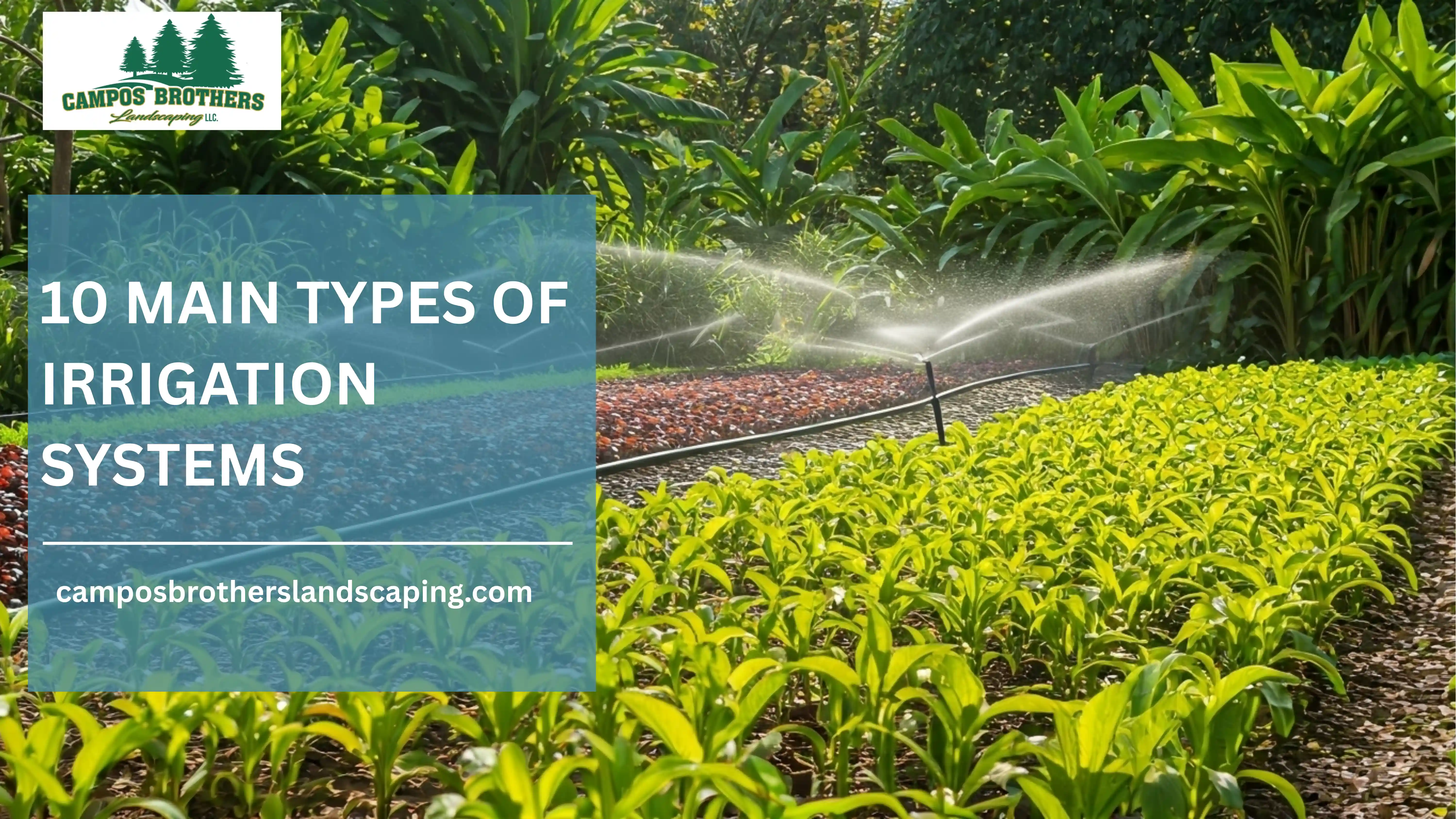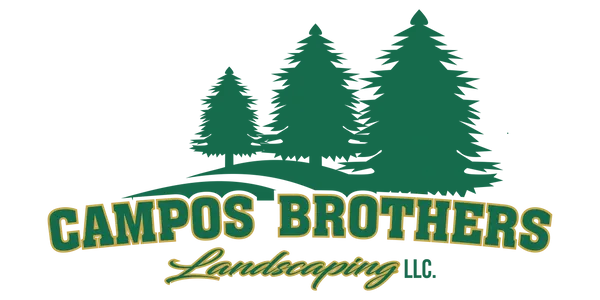10 Main Types of Irrigation Systems for Agriculture

Shrewsbury homeowners face a challenge every spring. Garden hose centers showcase dozens of irrigations options, but choosing the right systems for your specific landscape can feel overwhelming. Different plants need different watering approaches, and Massachusetts weather patterns create unique requirements that generic systems don't always address well.
Campos Brothers Landscaping helps property owners navigate these decisions by understanding how various irrigation systems perform in Central Massachusetts conditions. The right choice depends on factors like soil type, plant varieties, property size, and long-term maintenance preferences.
1. Introduction
2. Irrigation System Repair Tips for Surface Irrigation Methods
3. Find Reliable Irrigation System Repair Near Me for Sprinkler Systems
4. Drip Irrigation Systems
5. Top Irrigation System Companies Near Me Offering Center Pivot Solutions
6. How an Irrigation Sprinkler System Compares to Subsurface Irrigation Methods?
7. Irrigation System Definition and Its Role in Smart Irrigation Technology
8. Key Irrigation System Parts to Consider When Choosing the Right System
9. Essential Irrigation System Installation and Maintenance Tips
10. What Is Garden Irrigation System Types And Benefits?
Irrigation System Repair Tips for Surface Irrigation Methods
Surface irrigations represents the most basic approach to landscape watering, using gravity to distribute water quality across ground surfaces . This method works particularly well for larger flat areas where lot of water can flow evenly without creating runoff problems .
Flood irrigation system involves applying water pressure to entire areas and allowing natural absorption, while basin irrigation system creates controlled pools around individual trees or plant groups.
The main advantage of surface irrigations lies in its simplicity and low equipment costs.
Property owners can implement basic versions without complex installation requirements. However, success depends heavily on proper slope management and soil conditions that allow adequate absorption without excessive runoff .
Find Reliable Irrigation System Repair Near Me for Sprinkler Systems
Sprinkler systems remain the most popular choice for residential landscapes because they adapt to virtually any garden configuration . These systems distribute amount of water through pressurized spray patterns that can cover both small flower beds and expansive lawn large areas effectively . Modern sprinkler technology includes fixed spray heads, rotating sprinklers, and specialized micro-sprinklers for different applications.
Fixed spray heads work well for smaller defined areas like flower beds and foundation plantings . Rotating sprinklers cover larger areas more efficiently than stationary heads, making them suitable for lawn areas that need consistent coverage . The flexibility of sprinkler systems allows homeowners to adjust spray patterns and modify coverage areas as landscapes evolve over time .
Water efficiency varies significantly between different sprinkler types, with traditional systems typically achieving around 80% application efficiency . However, proper installation and maintenance can improve these numbers substantially .
Drip Irrigation Systems
Drip irrigations water supply directly to plant root zones through networks of flexible tubing and precision emitters . This targeted approach typically reduces water usage by 30-50% compared to sprinkler systems while often producing healthier plants . The slow, steady delivery allows complete soil absorption without runoff, even on slopes where sprinkler systems might create erosion issues.
Modern drip systems include pressure-compensating emitters that maintain consistent flow rates regardless of elevation changes throughout the system . Self-flushing mechanisms clear debris from emitter pathways, reducing maintenance requirements that historically made drip systems less attractive for busy homeowners.
Drip irrigations works particularly well for garden beds, around trees, and for container plants that need regular moisture without waste . The modular design allows easy expansion or modification as landscape needs change.
Top Irrigation System Companies Near Me Offering Center Pivot Solutions
Center pivot systems feature mechanical arms that rotate around central water sources, creating large circular watering patterns . While primarily used in agricultural applications, smaller residential versions work well for properties with extensive lawn dry areas or commercial landscapes requiring efficient coverage.
The rotating mechanism operates at relatively low pressure, distributing water waste evenly across large spaces without the energy costs associated with high-pressure systems . Variable rate technology allows different sections of the pivot arm to apply varying amounts of water based on soil conditions and plant needs in different zones.
How an Irrigation Sprinkler System Compares to Subsurface Irrigation Methods?
Subsurface drip irrigation tubing operates entirely below ground, delivering water directly to root zones through buried pipe networks. This approach eliminates surface evaporation while maintaining optimal soil moisture levels throughout growing seasons. Installation requires more initial planning and investment, but operating costs remain low due to eliminated evaporation losses and reduced maintenance needs.
Underground current system protect irrigations components from weather damage, lawn sprinkler system equipment impacts, and general wear affecting surface installations. The aesthetic advantages include landscapes without visible forms of irrigation equipment cluttering views or interfering with recreational activities.
Root zone efficiency of irrigation maintains consistent soil moisture that promotes deeper root development compared to surface watering methods. Plants develop stronger, more drought-resistant root systems when water management is available at deeper soil levels rather than just surface layers.
Irrigation System Definition and Its Role in Smart Irrigation Technology
Smart irrigation controllers use weather data, soil moisture sensors, and evapotranspiration rates to adjust uneven watering schedules automatically . These devices ensure landscapes receive appropriate water amounts based on real-time conditions, reducing waste while promoting plant health . Some controllers sync with local weather stations or use on-site sensors to avoid overwatering during rainy periods .
Smart technology can save thousands of gallons of water per season when used correctly . The systems alert property owners to problems like leaks or electrical issues before plant damage occurs . Remote access through smartphone apps allows irrigations management from anywhere, providing convenience for busy homeowners .
Key Irrigation System Parts to Consider When Choosing the Right System
Garden size and layout significantly influence system selection . Drip irrigation fittings works best for individual plants and smaller gardens, while sprinkler systems better serve larger lawns or mixed landscapes . Property accessibility affects installation costs and ongoing maintenance requirements .
Plant water requirements vary considerably between species and growing conditions . Some plants thrive with deep, infrequent watering that drip systems provide, while others benefit from the broader coverage that sprinklers deliver . Local climate conditions, including seasonal rainfall patterns and humidity levels, also influence optimal system selection .
Massachusetts weather patterns concentrate most outdoor watering needs into approximately seven months annually, creating seasonal demand fluctuations that affect both system performance and maintenance scheduling . Understanding these cycles helps property owners optimize their irrigations investments .
Essential Irrigation System Installation and Maintenance Tips
Professional installation ensures proper soil preparation, appropriate component spacing, and optimal timing for successful establishment . Expert designers create layouts that provide year-round functionality while supporting local plant requirements through strategic system selection .
Maintenance requirements differ significantly between system types . Drip systems need regular emitter cleaning and periodic line flushing . Sprinkler systems require ongoing head adjustment and occasional component replacement . Subsurface systems need minimal maintenance once properly installed but are difficult to modify without excavation .
Annual maintenance costs typically range from $300 to $1,000 depending on system complexity and property size . Professional service contracts can provide predictable costs while ensuring optimal system performance throughout operating seasons .
Selecting appropriate irrigation system transforms landscape maintenance from constant worry into automated support for healthy plant growth throughout growing seasons. Understanding the advantages and limitations of surface irrigations, sprinkler systems, drip technology, center pivot equipment, and subsurface methods helps property owners make informed decisions that match their specific needs and conditions. Success requires balancing immediate installation costs against long-term value while choosing contractors with proven expertise in Massachusetts conditions.
For Shrewsbury residents seeking professional irrigation system design and installation, Campos Brothers Landscaping provides comprehensive expertise in matching optimal solutions to local soil conditions and individual landscape requirements.
What Is Garden Irrigation System Types And Benefits?
Irrigation system come in various types, including drip, sprinkler, and surface irrigation. Each type offers unique benefits: drip systems conserve water by delivering it directly to roots, sprinklers cover larger areas efficiently, and surface irrigation is cost-effective for flat landscapes. Choosing the right system maximizes efficiency and crop yield.
